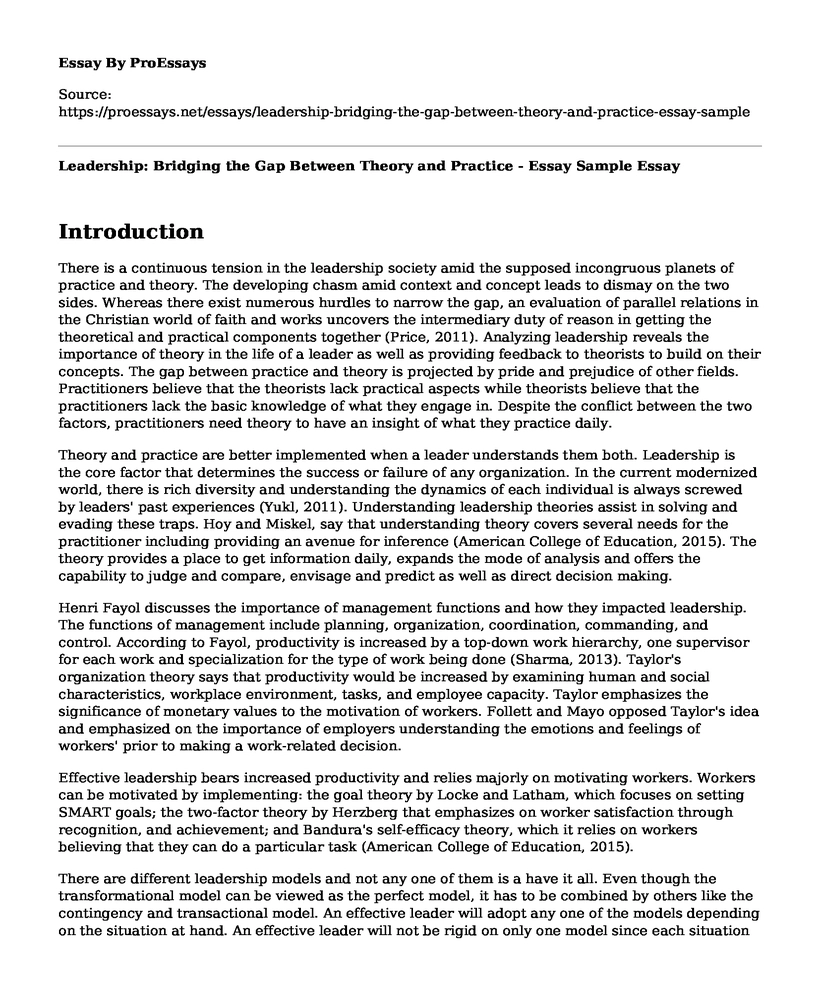Introduction
There is a continuous tension in the leadership society amid the supposed incongruous planets of practice and theory. The developing chasm amid context and concept leads to dismay on the two sides. Whereas there exist numerous hurdles to narrow the gap, an evaluation of parallel relations in the Christian world of faith and works uncovers the intermediary duty of reason in getting the theoretical and practical components together (Price, 2011). Analyzing leadership reveals the importance of theory in the life of a leader as well as providing feedback to theorists to build on their concepts. The gap between practice and theory is projected by pride and prejudice of other fields. Practitioners believe that the theorists lack practical aspects while theorists believe that the practitioners lack the basic knowledge of what they engage in. Despite the conflict between the two factors, practitioners need theory to have an insight of what they practice daily.
Theory and practice are better implemented when a leader understands them both. Leadership is the core factor that determines the success or failure of any organization. In the current modernized world, there is rich diversity and understanding the dynamics of each individual is always screwed by leaders' past experiences (Yukl, 2011). Understanding leadership theories assist in solving and evading these traps. Hoy and Miskel, say that understanding theory covers several needs for the practitioner including providing an avenue for inference (American College of Education, 2015). The theory provides a place to get information daily, expands the mode of analysis and offers the capability to judge and compare, envisage and predict as well as direct decision making.
Henri Fayol discusses the importance of management functions and how they impacted leadership. The functions of management include planning, organization, coordination, commanding, and control. According to Fayol, productivity is increased by a top-down work hierarchy, one supervisor for each work and specialization for the type of work being done (Sharma, 2013). Taylor's organization theory says that productivity would be increased by examining human and social characteristics, workplace environment, tasks, and employee capacity. Taylor emphasizes the significance of monetary values to the motivation of workers. Follett and Mayo opposed Taylor's idea and emphasized on the importance of employers understanding the emotions and feelings of workers' prior to making a work-related decision.
Effective leadership bears increased productivity and relies majorly on motivating workers. Workers can be motivated by implementing: the goal theory by Locke and Latham, which focuses on setting SMART goals; the two-factor theory by Herzberg that emphasizes on worker satisfaction through recognition, and achievement; and Bandura's self-efficacy theory, which it relies on workers believing that they can do a particular task (American College of Education, 2015).
There are different leadership models and not any one of them is a have it all. Even though the transformational model can be viewed as the perfect model, it has to be combined by others like the contingency and transactional model. An effective leader will adopt any one of the models depending on the situation at hand. An effective leader will not be rigid on only one model since each situation is unique from the other. There are situations that will require punishment or reward, yet there are others that will require the leader to step in and lead the subordinates.
References
American College of Education. (2015). Organizational Behavior and Culture.
Price, J. (2011). Unifying leadership: Bridging the theory and practice divide. Journal of Strategic Leadership, 3(2), 13-22.
Sharma, M. K., & Jain, S. (2013). Leadership management: Principles, models and theories. Global Journal of Management and Business Studies, 3(3), 309-318.
Yukl, G. (2011). Contingency theories of effective leadership. The SAGE handbook of leadership, 24(1), 286-298.
Cite this page
Leadership: Bridging the Gap Between Theory and Practice - Essay Sample. (2023, Apr 24). Retrieved from https://proessays.net/essays/leadership-bridging-the-gap-between-theory-and-practice-essay-sample
If you are the original author of this essay and no longer wish to have it published on the ProEssays website, please click below to request its removal:
- Factors That Enhance Multicultural Communication for Virtue Teams Paper Example
- Essay on Impact of Leadership on the Implementation of a Current or Recent Development
- Responsibilities of Managers and Leaders Essay Example
- Essay Example on Evidence-Based Decision-Making: Maximizing Favorable Outcomes
- Essay Sample on Gap Inc.'s Competitive Strategy: Differentiation & Best-Cost Provider
- Fostering Team Cohesion: Human Structural Dynamics and Team Interventions - Essay Sample
- Human Capital Management - Essay Example







